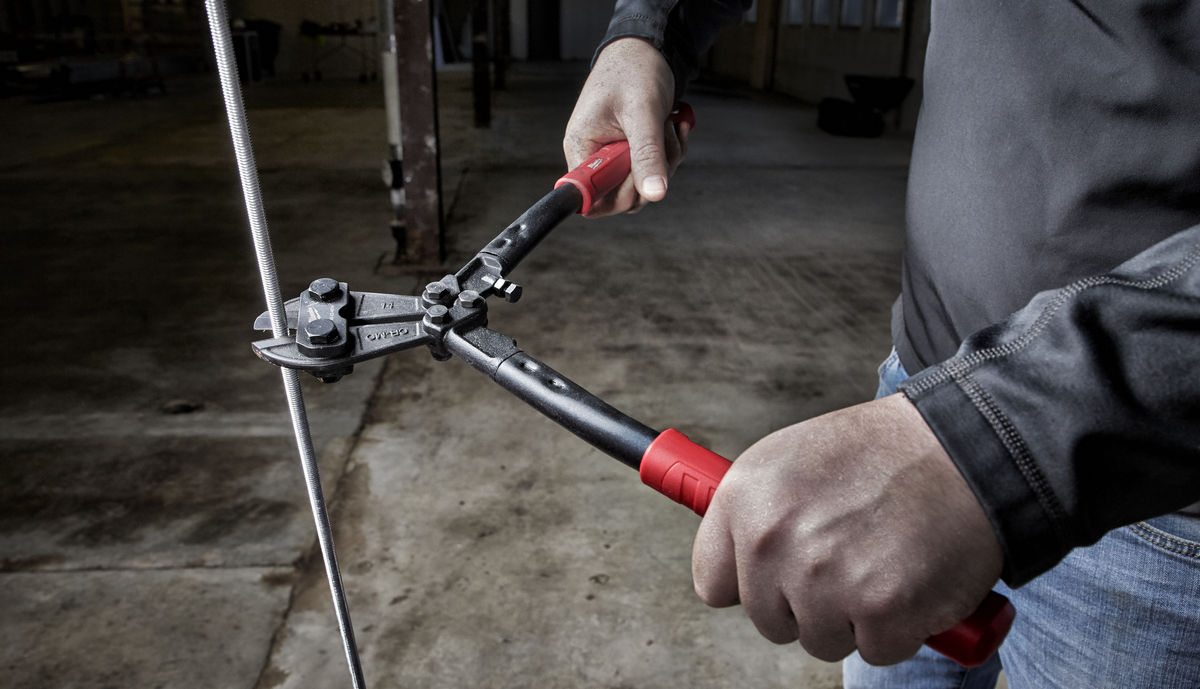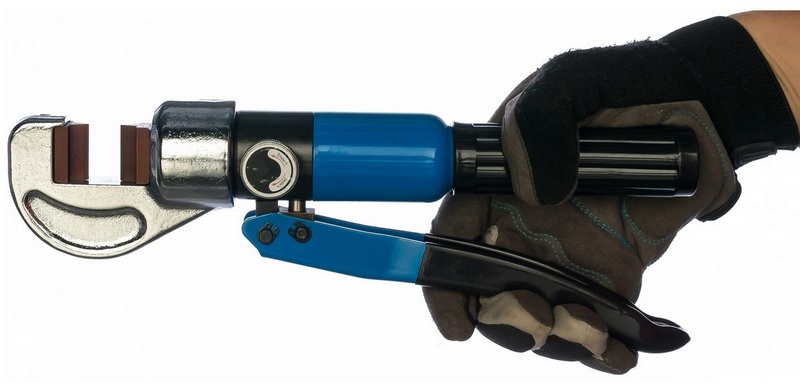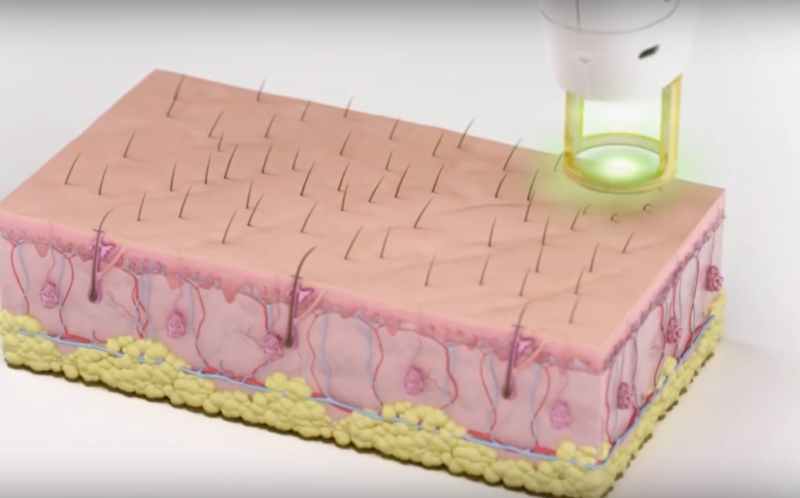Ranking of the best bolt cutters for 2025

Reinforcing scissors (they are also bolt cutters) are a pliers tool. Designed for cutting iron rods with different diameters, cables and wires, pipes and studs, bolts and other types of fasteners with a hexagonal, round or square section, made on the basis of steel or other metal. During operation, their levers-handles are driven by human muscle power or hydraulics, and they transfer pressure to their cutting parts - heads or sponges. This design allows you to cut rather thick objects with only small efforts. The work of the jaws provides the future place of the cut with proper evenness and cleanliness, which is important, for example, for bolted fasteners.

Content [Hide]
General information
The principle of operation of the device in question is the implementation of the double lever mechanism. Structurally, any such tool consists of two sponge blades, one of which has a sharp sharpening, and the other is slightly blunt. An object for cutting is installed between these sponges, and when exposed to long working levers, it is bitten.
Bolt cutters can be used in a wide range of work areas. Most often, they are an indispensable device in the arsenal of rescuers during rescue operations, since they are useful for cleaning and unblocking blockages / passages.
All reinforcing scissors can be divided into two main types:
- Manual (mechanical) - usually used in everyday life and are designed to cope with small-scale work. They have limitations in performance, because they are completely dependent on the muscular strength of the operator, which drives the lever mechanism;
- Hydraulic - they are characterized by much larger dimensions, an expanded scope, because. they do not depend on the physical strength of the user at all.The cutting mechanism is activated by means of a hydraulic cylinder, which pumps the necessary pressure in itself with the help of a special fluid.
Scope of application
The considered type of devices is widely used in the following areas:
- Industry - bulky and powerful variations of bolt cutters are used there, which in general most often have a stationary design. They are installed in metal processing shops, where they carry out the production and cutting of blanks.
- Home life - low-power manual models are more popular there, which are easy to bite through a thin fence wire or crack a jammed padlock.
- Repair shops (SRT) - here scissors are used to dismantle failed spare parts.
- Rescue work - reinforcing scissors have long been part of the mandatory emergency kit of any rescue team. They can easily dismantle damaged structures (from parts of cars to fragments of houses), which can interfere with the rescue of people on the other side. Also, it is convenient for them to overcome interfering obstacles in the form of locks, loops, chains, etc.
- Construction - here bolt cutters are used strictly for their intended purpose and they cut reinforcement embedded in concrete structures.
Working Capabilities
In most cases, they will depend on the size of the tool, namely, on the size of its handles (especially true for mechanical models). On the other hand, the very design and shape of the sponge-blades will also play an important role. The likelihood of being able to cut a large object or an object made of reinforced material can also be increased by using replaceable blades - this option for improving the tool is considered the most reliable.Replacement jaws are available for both mechanical and hydraulic models and come in the following types:
- Centrifugal - with them, the movement of the sponges occurs symmetrically and at an equal distance from the surface of the object being cut. Such equipment is considered standard and most models of non-separable type work according to this principle. From this it is clear that such a removable set for collapsible bolt cutters is only a spare consumable.
- Flat - they are specially designed for cutting iron sheets. Be sure to be supplied with a template for trimming strips to the same width.
- Angular - on such sponges, the cutting plane has a slope of 24-35 degrees to the axis of the object being bitten. In the place where the object is clamped by the blades, a special thrust plate is installed, which provides the possibility of slipping. It can be moved and finally fixed in the desired position by means of a pin. For comfortable cutting in places with limited access, the nozzle can be turned 180 degrees relative to the axis of the object being processed.
Modern types of bolt cutters
Depending on the design and location of all working elements, as well as on the source of the driving force, the type of tool in question is divided into four types.
- Mechanical (manual).
This sample is held directly in the hands of the operator and is driven by his muscular strength. In this case, one handle is constantly in a static position, and the second works as a lever and builds up pressure. The applied force is always applied in steps, not all at once. Accordingly, by applying several small pressures instead of one long one, it is possible to significantly facilitate the work process and reduce the percentage of effort required from the operator.Therefore, a manual bolt cutter can be easily used by a person who does not even have great physical strength. However, this type of reinforcing shears is characterized by a significant loss in the speed of operations.
- Scissor and guillotine.
They differ from each other in the design of the cutting jaws. In the scissor variation, they are made in the form of open blades (exactly like standard wire cutters), while one blade is always stationary, and the second is driven by the cylinder rod. This design is typical for mechanical devices. In the guillotine design, the cutting part is represented by a truncated geometry knife, which moves towards the second pointed knife during operation. Both jaws are slightly offset relative to each other, and this allows you to cut even thick objects made of carbon steel with extreme efficiency. The guillotine design is more suitable for industrial bolt cutters.
- Electrohydraulic.
In these devices, in the hydraulic cylinder, the pressure is formed not by the muscular strength of the operator, but by means of a special pump, which gradually presses on the working fluid. The pump is powered by an electric motor, which is also located on the body of the device. Depending on the thickness of the object to be cut, electro-hydraulic shears can be sized accordingly. From this it is clear that the more powerful the motor of the unit, the greater the thickness the tool itself can handle. These samples, with their medium-sized variations, are deservedly considered universal and serve equally well for both domestic and industrial purposes.
- Devices with a dedicated pump.
These are the largest devices among those considered.However, their cutting part may not be very large, but the power hydraulic cylinder is necessarily an impressive part of the whole structure. It is equipped with a special sleeve connected to an external pump, which will provide maximum pressing force when making a cut. It is this circumstance that allows the tool to bite even the thickest objects.
Advantages of hydraulic models over mechanical ones
Only a grinder (“grinder”) can compete in performance with hydraulic shears, and even then only its specialized versions. Therefore, it is simply impossible to talk about rivalry in this regard between hydraulic bolt cutters and mechanical ones. Moreover, hydraulic models have several particularly important advantages:
- Absolute energy independence;
- Extremely weak and far from fast wear of cutting elements;
- No sparking during operation;
- Reduced risk of injury due to the presence of protective mechanisms (on most models);
- Relative noiselessness (if you do not take into account specialized stationary industrial models powered by an external pump).
Speaking of mechanical bolt cutters, we can note their following "cons":
- Cutting a very thick object (for example, crossbars on a powerful lock) requires considerable physical strength of the operator and certain skills.
- Manual models are good for infrequent use and are in no way suitable for intensive work of the inline type. Therefore, they are intended for the domestic sphere, because there are no small amounts of work in production and construction.
- All mechanical models have a limit to their operational capabilities - they can cut a bar with a diameter of 18 millimeters from standard grades of steel (and for alloy and carbon steel, this figure is even less). But any hydraulic shears, even their simplest variations, can easily cope with a diameter of 30 millimeters (not to mention stationary industrial designs).
Rules for safety, care and operation of reinforcing shears
In principle, the type of tool in question does not belong to the category of devices that pose an increased danger to the operator during work. However, it is still necessary to follow some immutable rules that will ensure both the safety and efficiency of all working manipulations:
- Before using the tool, you must carefully read the instructions attached to it and carefully study all the recommendations of the manufacturer.
- Immediately before work, you need to check the integrity of the device, the tightness of all moving parts and the sharpness of the cutting edges.
- The tool must be fully tuned and adjusted for the operator.
- It will not be superfluous for the operator to put on protective clothing - gloves, suit / apron, helmet, goggles;
- It is always worth remembering that cutting is possible only on the material that is available for a particular model of scissors. You should not try to bite through thick, concrete-reinforcing reinforcement with a household bolt cutter.
- At the end of the work, the bolt cutters must be thoroughly cleaned (this is a mandatory step for all hydraulic devices).
- The device itself must be stored in a completely dry place out of the reach of children.
Difficulties of choice
Before buying a bolt cutter, you should carefully examine all the technical parameters and capabilities of the model you like. You should also take care of the following nuances:
- The thickness of the objects to work with. If it is necessary to process objects with a thickness of up to 10 millimeters, then hydraulic models will be a waste of money - here it is quite possible to get by with mechanical samples.
- If the tool is purchased for intensive professional activities, then it is better to choose a model with a hydraulic booster. It can be used with maximum efficiency even where there is no access to electricity.
- Be sure to inspect the body of the bolt cutter, determine the strength of the material from which it is made, and its cutting parts. The blades must be made of high-strength steel, regardless of what design is used for them (guillotine, angle, centrifugal).
- Make sure that you can disassemble the product yourself. This will allow you to personally carry out a thorough cleaning, replace failed elements or rearrange (if the design allows) interchangeable cutting nozzles.
Ranking of the best bolt cutters for 2025
hydraulic samples
4th place: "Hydraulic manual KBT BRG-12 67657"
votes 0
The model serves both for cutting bolts and for cutting reinforcement with a diameter of 4 to 12 mm. The cut occurs with a force of 5 tons. The tool is equipped with a manual pressure release valve that resets the blades. The tool is supplied in a plastic case. Net weight, kg - 2.3, blade hardness HRC - 52…54. There is a backlash-free fit of the blades, a manual pressure relief valve, a reinforced C-shaped working head.The recommended cost for retail chains is 5870 rubles.

- Easy and quick replacement of consumable blades while maintaining the functionality of the tool;
- Weight of the kit / tool - 2.30 / 1.70 kg;
- Comfortable working length - 295 mm;
- There is a convenient case for transportation.
- Not detected.
3rd place: "Hydraulic BRG-16 KVT 67658"
votes 0
The tool allows you to easily cut bolts and bars with a diameter of up to 16 mm using a pressure of 8 tons. The compact and robust instrument is equipped with a manual pressure relief valve. The bolt cutter comes with a plastic case and cutting blades installed in the tool. Blade hardness is HRC 52…54. There is a backlash-free fit of the blades and a reinforced C-shaped working head. The recommended cost for retail chains is 9800 rubles.

- Maximum force - 8 tons;
- Two-speed pump;
- The weight of the kit is 2.30 kilograms;
- The total length is 415 mm.
- Not detected.
2nd place: "Hydraulic KVT BRG-22 69243"
votes 0
The device is designed for cutting bolts and steel fittings with a diameter of 4-22 mm. The maximum cutting force is 12 tons, the tool has a special valve to relieve pressure. The working reinforced part is made in a C-shape. Bolt cutter with backlash-free blades. The cutting blades are made of tool steel. Handles are dressed in rubber covers. The total weight is 4.9 kilograms with a total length of 490 millimeters. The recommended cost for retail chains is 10,900 rubles.

- Blade hardness is HRC 52…54;
- There is a backlash-free fit of the blades with a stem guide;
- Two speed pump.
- It is impossible to apply on rods more than 22 millimeters.
1st place: "Hydraulic TOR HHG-20 4-20 mm 12 t"
votes 0
The sample is characterized by a high level of safety during operation. It has durable replaceable knives, which are made of high hardness steel. The tool is completely autonomous. Due to its compactness and low weight, it is convenient to use it in hard-to-reach places of work. The working head is made in the shape of the letter “C”. It is used for cutting reinforcing steel bars, steel bars of square, round, hexagonal section, as well as products made of other high-strength materials. The recommended cost for retail chains is 13,500 rubles.

- High pressing force;
- Easy work even on the hardest materials;
- Complete autonomy.
- Not detected.
Mechanical samples
4th place: "STAYER Hercules Forge, compact, Cr-V, 200mm"
votes 0
This is a reliable professional tool for cutting non-hardened bolts, steel and metal bars with a diameter of up to 3.5 mm, and hardened ones with a diameter of up to 2 mm. The jaws are made from chrome vanadium steel and are high frequency hardened for increased strength and wear resistance. Ergonomically shaped one-component handles fit comfortably in the hand and do not slip. Length - 200 millimeters, weight - 320 grams. The recommended cost for retail chains is 720 rubles.

- Dielectric protection;
- Durable material of the cutting part;
- Adequate cost.
- Not detected.
3rd place: "POWER TOOLS" 60 cm.Scrab 22904"
votes 0
The device is used for cutting all kinds of bolts, studs, wire, the diameter of which does not exceed 8 mm. This bolt cutter is made of high-strength steel, and the cutting edges are made of a special alloy, which increases the service life of the tool. It easily works on ordinary steel, hardened steel and various carbide materials. The recommended cost for retail chains is 1050 rubles.

- Non-slip coating of the case;
- Rubber coated handles;
- Small sizes.
- Not detected.
2nd place: "KRAFTOOL 200mm X-BOLT 23283-20"
votes 0
This sample is designed for cutting metal and steel bars, including hardened ones. It is made of high quality chrome vanadium steel, meets the highest technical requirements, and the phosphated coating protects the device from corrosion. It has an increased resource and provides long-term and high-quality work. Hardening the jaws with high frequency currents indicates a long tool life. The high-power double-lever mechanism of handles increases force of a cut. Weight is 290 grams, length - 200 millimeters. The recommended cost for retail chains is 1420 rubles.

- Handles - poured one-component;
- Sponge material - chrome vanadium;
- Real value for money.
- Not detected.
1st place: "STAYER Hercules reinforced connector 1050 mm 2330-107"
votes 0
This professional and reliable tool for cutting metal and steel bars, including hardened ones. The jaws are made of high quality tool steel and hardened by high frequency currents.They can cut non-hardened wire with a thickness of up to 23 mm, and hardened wire - up to 12 mm. The total length of the device is 1050 mm, the material of the jaws is steel grade T8, the handles are one-component. The recommended cost for retail chains is 3560 rubles.

- Quality brand workmanship;
- Strong steel cutting edges;
- Professional orientation of the unit.
- Somewhat overpriced.
Conclusion
A good master should have many different useful tools in his arsenal. One of them is a bolt cutter, which is represented by different types of variations. In order for the tool to meet the stated requirements, it is important to choose the right model, depending on the conditions for its further operation. The durability of the device will be ensured by competent work with it and proper storage conditions.
new entries
Categories
Useful
Popular Articles
-

Top ranking of the best and cheapest scooters up to 50cc in 2025
Views: 131652 -

Rating of the best soundproofing materials for an apartment in 2025
Views: 127691 -

Rating of cheap analogues of expensive medicines for flu and colds for 2025
Views: 124520 -

The best men's sneakers in 2025
Views: 124034 -

The Best Complex Vitamins in 2025
Views: 121940 -

Top ranking of the best smartwatches 2025 - price-quality ratio
Views: 114981 -

The best paint for gray hair - top rating 2025
Views: 113396 -

Ranking of the best wood paints for interior work in 2025
Views: 110319 -

Rating of the best spinning reels in 2025
Views: 105330 -

Ranking of the best sex dolls for men for 2025
Views: 104367 -

Ranking of the best action cameras from China in 2025
Views: 102217 -

The most effective calcium preparations for adults and children in 2025
Views: 102012









